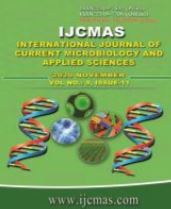


 National Academy of Agricultural Sciences (NAAS)
National Academy of Agricultural Sciences (NAAS)

|
PRINT ISSN : 2319-7692
Online ISSN : 2319-7706 Issues : 12 per year Publisher : Excellent Publishers Email : editorijcmas@gmail.com / submit@ijcmas.com Editor-in-chief: Dr.M.Prakash Index Copernicus ICV 2018: 95.39 NAAS RATING 2020: 5.38 |
A comparative study was conducted on the tubal tonsil of six adult male crossbred goats and Large White Yorkshire pigs. Macroscopically the tubal tonsil were found in the nasopharynx, caudal to and around the openings of the auditory tubes as a thick raised mass of small nodules 4 to 5 cm in length in the pigs while in goats the small nodules were seen scattered. In histological sections the tubal tonsil in goats and pigs were lined by pseudostratified ciliated columnar epithelium. Surface of the tubal tonsil showed folds and invaginations which formed crypts where, the epithelium was modified into follicle-associated epithelium (FAE), also called lympho-epithelium. There was no significant difference in the height of crypt epithelium between both the groups of animals used in the present study. Propria-submucosa was filled with primary and secondary lymphoid nodules and diffuses lymphoid tissue arranged as crypto-lymphatic units (CLU) and tonsillar nodules in the superficial lamina propria. The tubal tonsil was encapsulated and well developed in pigs but in goats the tubal tonsils were not macroscopically distinguishable from the surrounding tissue and were not encapsulated. On statistical analysis significant differences (p ≤ 0.01) were observed in the average number and diameter of the lymphoid nodules, and number of lymphocytes per nodule. The average number and diameter of the lymphoid nodules, and number of lymphocytes per nodule was more in Large White Yorkshire pigs when compared to crossbred goats, offering them better mucosal immunity by guarding the auditory openings of eustachian tube.
 |
 |
 |
 |
 |